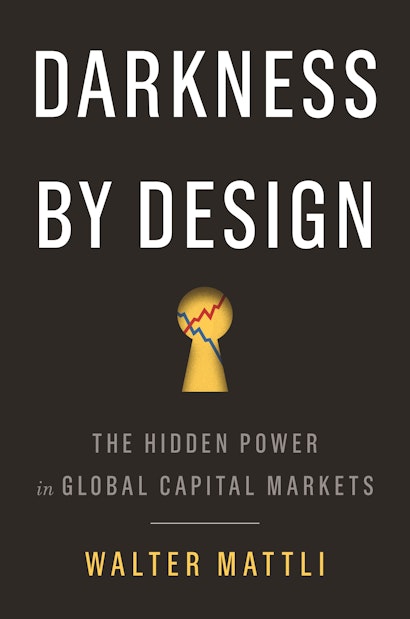Capital markets have undergone a dramatic transformation in the past two decades. Algorithmic high-speed supercomputing has replaced traditional floor trading and human market makers, while centralized exchanges that once ensured fairness and transparency have fragmented into a dizzying array of competing exchanges and trading platforms. Darkness by Design exposes the unseen perils of market fragmentation and “dark” markets, some of which are deliberately designed to enable the transfer of wealth from the weak to the powerful. Essential reading for anyone with money in the stock market, Darkness by Design challenges the conventional view of markets and reveals the troubling implications of unchecked market power for the health of the global economy and society as a whole.
How did you come to write this book?
WM: Right after the 2007-2008 financial crisis I became interested in questions regarding the regulation of big banks in order to prevent abuse, market distortions, and further scandals and crises. I wanted to look at the ways in which the very same contributors to the financial crisis benefited from it, but I discovered that a number of financial experts were already examining the topic and producing very insightful research. I thus decided to shift my attention to an important related area that many knew little about: the structure and governance of capital markets. After talking to several dozen market actors and doing some preliminary research, what struck me as particularly interesting was the puzzling transformation of equity market structure: the move from centralized to fragmented markets in the early 2000s. I wasn’t convinced by the conventional view of this transformation; I therefore began to investigate the question of market structure and governance more carefully. In the process, I made interesting discoveries that I felt should be explored more fully and presented to a broad audience.
Can you explain the title? What exactly is being hidden?
WM: A retired regulator with a distinguished 15-year record at the helm of two major financial regulatory organizations confessed to me that he no longer understands how these complex capital markets really work. The average investor is even more in the dark about these markets. When an investor sends an order to buy or sell a stock by the click of a mouse, the order may take a lightning journey through a maze of dark pools and exchanges before being filled. How does the investor know that on the journey to execution the order was treated fairly and was filled at the best available price? The title, Darkness By Design, refers to almost invisible exploitative trading schemes or arrangements in today’s capital markets that are deliberately designed and governed to enable the transfer of wealth from the weak to the powerful. To understand the mechanism of such exploitation, it is important to go beyond conventional accounts of how markets work and acknowledge the extent to which markets are political organizations. What the many conventional accounts of the function of markets overlook is the extent to which markets are deeply political organizations or governance systems where what is being hidden is the extent to which power politics shapes markets. Contending groups intensely battle to shape market rules and structure according to their own narrow preferences. Power is central to explaining markets both in the sense of general power politics arguments about who wins or loses, and in the sense that markets themselves are political institutions governed by power relations.
What are the origins of the market fragmentation that we’re seeing today?
WM: It’s worth recalling that for over two centuries, securities markets in all major countries tended toward greater concentration. Concentration of trading in one large organized public market or trading “pool” seemed natural and inevitable, because the greater the number of users of an exchange the more attractive that exchange is to new or potential users, since new buyers and sellers are more likely to find a counter-party in a large market than in a small one. That is to say, a central market naturally has the highest concentration of orders: it has the greatest trading depth (volume of bids and offers) as well as breadth (range of tradeable securities). In other words, it has the highest liquidity, and liquidity begets liquidity: the bigger the flow of trades, the stronger the pull. My book questions the conventional view of the move from centralization to fragmentation that says that centralized markets were monopolistic and inefficient and that this led to the fragmentation of the market. In this narrative, investors are the principal beneficiaries owing to narrower trading spreads and lower commissions, but this deeply entrenched conventional view is flawed. A key finding of my book is that power politics caused the market fragmentation—it was a plot by a coterie of powerful insiders who had grown weary of the traditional way of organizing trading, viewed the old model increasingly as contrary to their economic interests, and quietly pushed for a different market structure more aligned with those interests.
How is market fragmentation hurting us now?
WM: In today’s fragmented markets characterized by many “shallow” pools of liquidity—a proliferation of public exchanges, broker-dealer dark pools, and other private off-exchange trading places—costly new technology is often used by powerful market operators in quiet and nearly invisible ways to maximize their profits at the expense of ordinary investors. Specifically, information asymmetries and secrecy—often deliberate governance-design strategies—have enabled a small but powerful group of unscrupulous market operators to milk conflicts of interest, often in undisclosed or hidden ways, at the expense of the unsuspecting investing public. Latent in the minds of many victims of these strategies is a belief that “modern” markets are technologically determined and that technological progress must be good. But new technology is neither bad nor good; its social value is solely determined by the incentives or motives of the users of this technology. The rise of fragmentation, or market transformation more generally, matters because it shapes the incentives of market actors to invest in either good or bad governance. Good governance is about managing conflicts of interest for the long-term benefit of all in society whereas bad governance milks the conflicts of interest for the benefit of the few on the backs of the many. Over the past decade and a half, fragmentation has given rise to bad governance. Market makers have fewer obligations, market surveillance is neglected or impossible, and enforcement is rendered ineffective. It is important to note that market fragmentation is by no means limited to the US equity market. Elsewhere, too, market centralization has been replaced by varying levels of fragmentation.
Is this story all doom and gloom? Are there any positives? What would have to happen to address the issues related to market fragmentation?
WM: Darkness by design is not inevitable—the mantle of darkness can be lifted through a combination of steps based on several fundamental principles, including market transparency based on stringent disclosure rules and robust market intelligence, a level playing field for market participants, proper accountability for market disruption and bad governance, and, crucially, market consolidation or centralization. The reason is that dominant exchanges in such market systems have particularly strong reputational concerns and the requisite financial resources to invest in good governance. Dominance means high public visibility, which brings with it great reputational vulnerabilities. In highly fragmented market systems, the many market organizations have an incentive to cut corners. Why focus on delivering high quality public goods, such as price discovery, if competitors can simply free ride, and, in addition, good money can be made by milking conflicts of interest? Once such behavior becomes permissive and the unspoken norm, no significant reputational costs result from engaging in, abetting, or condoning bad market behavior. Regulatory intervention in capital markets by governments plays a role in lifting the mantle of darkness. However, it is rarely the only answer and not necessarily the most effective one. It is bound to face considerable practical and especially political challenges, not least from powerful defenders of the status quo who will fight change tooth and nail. There is another answer: market solutions to market failures, sometimes nudged or facilitated by regulators. Specifically, greater consolidation and market centralization are possible—not through regulatory intervention but perhaps through market processes. Consolidation of markets at the national or transnational level, with one or more dominant exchanges, is likely to generate a fairer, simpler, more transparent, and more efficient marketplace than the one created by a fragmented system and characterized by shallow liquidity scattered across a wide range of exchanges, dark pools, and internalizers.
What do you hope readers will take away from reading this book?
WM: A key contribution of this book is the empirical analysis into historical patterns of market structure and governance. The book shows the market transformation that took place over time. Central to the analysis is the role of power politics in shaping market structure and governance: changes in the distribution of power in capital markets alter market actors’ relative influence in pushing for or opposing change. Specifically, over the last decade and a half, transformations have taken place which have resulted in fragmentation and badly governed markets, thereby adversely affecting aspects of quality and fairness in these markets. I hope the book will encourage readers to become more cautious and will equip them to ask tough questions of their brokers in order to better protect their interests when investing in capital markets.
Walter Mattli is professor of international political economy and a fellow of St. John’s College, University of Oxford. His books include The New Global Rulers: The Privatization of Regulation in the World Economy and The Politics of Global Regulation. He lives in Oxford, England.

